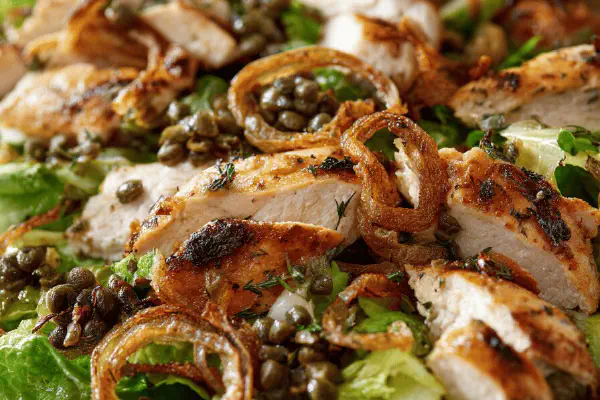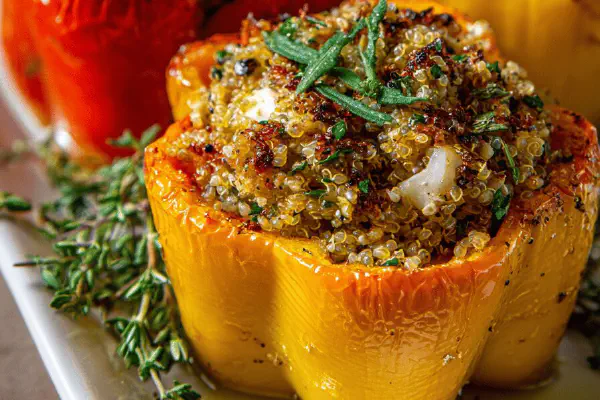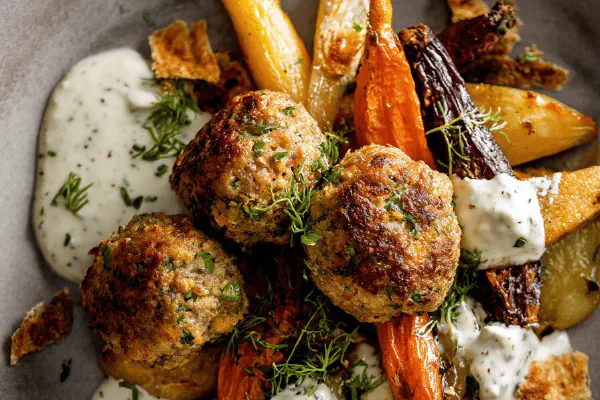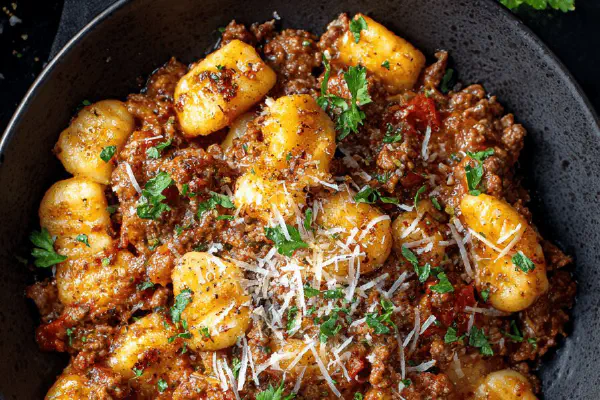Buttered Herb Roast Turkey
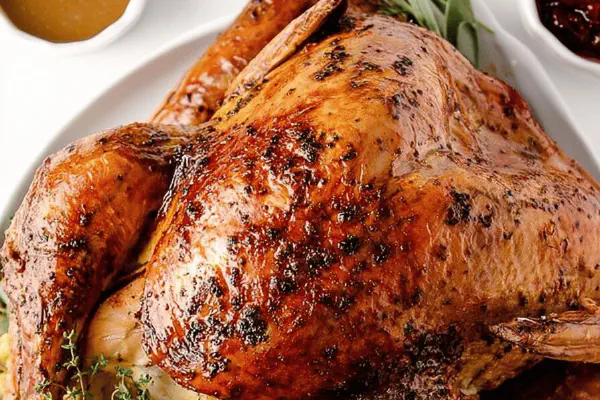
By Emma
Certified Culinary Professional
Ingredients
- 1 whole turkey, about 12 lbs
- 6 tbsp unsalted butter softened
- 2 tbsp fresh parsley chopped
- 1 tbsp fresh rosemary minced
- 1 tbsp fresh thyme leaves
- 1 tbsp fresh sage chopped
- 1 1/2 tsp kosher salt
- 1 tsp freshly ground black pepper
- 1 medium apple cut into quarters
- 2 celery stalks roughly chopped
- 1 small onion quartered
- 1 cup champagne or ginger ale (sub: dry white wine or apple cider)
- 3 tbsp unsalted butter (for gravy)
- 3 tbsp all-purpose flour
- 4 cups turkey or chicken broth
- Pan drippings from roasted turkey
About the ingredients
Method
Turkey
- Set oven at 345°F rather than strict 350°F; gives gentler heat. Line entire roasting pan with foil for easier cleanup but don’t cover completely on the bird yet.
- In a bowl, smash softened butter with herbs, salt, and pepper until all combine. Feel the coarse texture of fresh rosemary mingling with sage—aroma starts hitting hard.
- Run fingers carefully beneath turkey skin starting at neck opening sparing no section. That butter mixture gets spread thick right against the meat itself, a hidden layer of fat and herb power. Also smear a bit inside the cavity to keep flavor moist.
- Stuff apple, celery, and onion loosely inside the cavity. No need to compact — let steam circulate to build scent inside the bird while roasting.
- Plop turkey breast side up in foil-lined pan. Pour champagne or sparkling ginger ale over it to keep steam moisture and add subtle tang. Cover bird loosely with foil but avoid trapping it tight; skin mustn't touch foil or it sticks and tears.
- Slide pan into the oven. Bake for roughly 3 hours but listen for the subtle sizzling and watch juices bubbling near edges. Baste once every hour - lift foil carefully, spoon drippings back over skin. Keeps meat from drying out and gives that eventual shiny golden color.
- After about 3 hours, reveal turkey by removing foil entirely. Give it a last heavy baste then return uncovered for 25 to 30 minutes more, watching skin turn deep golden brown with crispy edges while juices run clear. Thigh meat hits about 178-180°F internal temp when done but eyeball texture too; it should yield easily under thumb pressure, juices running clear near the leg joint.
- Take turkey out, tent loosely with foil to avoid drying but let rest for 20-30 minutes. Rest is critical — meat fibers relax and reabsorb liquid, carving gets cleaner not stringy.
- Remove stuffed veggies from cavity - compost or use pie filling if you like faint flavors left inside. Carve carefully with a sharp knife, breast first, then legs and wings.
- Serve with gravy.
Gravy
- Heat 3 tbsp butter in saucepan over medium. Think slowly melted, no brown bits yet.
- Whisk in flour forming a paste - the roux. Keep stirring for up to 12 minutes until it darkens to light tan with a toasty nut aroma; patience here means flavor, don’t rush or burn it.
- Add broth slowly while whisking, then scrape pan drippings into sauce. Adjust thickness by adding broth or cooking down a bit. Bring to simmer, not boil, to thicken without breaking sauce.
- Taste. Salt and pepper as needed. Gravy should taste balanced - rich but not salty or bitter.
- Keep warm until ready to serve, stirring occasionally to prevent skin formation.
- Enjoy with turkey.
Cooking tips
Chef's notes
- 💡 Lift skin gently with fingers, no tearing allowed. Butter-herb massaging under skin means direct fat infusion into fibers. Thick layer works better than thin coat on top. Avoid cold butter - softer spreads easy. Start at neck edge, slide hand fully. Patience here saves drying out.
- 💡 Cavity stuffing gets loose, never packed tight. Steam needs space to swirl aroma. Apple cuts add gentle acidity but expect subtle scent only. Use celery and onion for moisture and complexity but no full-on stuffing flavor. Consider swapping apple for pear or mild citrus peel if needed.
- 💡 Oven temp set at 345°F is key—not the usual 350. Slightly lower heat meant less harsh browning first hours, slow fat rendering. Uses foil lining for easy cleanup but beware - foil must not touch skin or it sticks, tears. Cover loosely, allow air circulation. Watch juices, clear is doneness clue.
- 💡 Baste every hour but don’t drench - too wet skin won’t crisp. Use pan drippings spooned back, not broth or champagne. Last 25-30 mins, fully uncover to let skin turn deep golden. Look for crispy edges, listen for sizzling sounds near pan edge. Juice clarity near leg joint tells cooking done.
- 💡 Gravy roux demands slow stirring, up to 12 minutes for light tan, nutty aroma. Rushing burns, bitterness. Add broth gradually while whisking to avoid lumps. Add pan drippings last for flavor bombs; skim fat if grease builds. Keep warm on low, stir often to stop skin forming. Thin with broth if thickens chilled.
Common questions
How to avoid dry turkey breast?
Lift skin slowly, avoid tears. Pack butter-herb fat under skin against meat. Baste with pan juices hourly. Use cavity moisture – apple onboard. Rest tent loosely after cooking. Juices clear at leg means done not dry. Check texture, soft thumb pressure. Avoid high heat early on.
What if no fresh herbs?
Frozen chopped ok but reduce volume by half. Dried herbs must be crushed finely, less quantity. Aromas weaker but still add depth. Consider garlic powder or gentle onion powder for aromatic boost. Butter softening important to blend spices well into paste.
Why not cover foil tight over bird?
Tight foil traps steam directly on skin, leads to tearing when removing. Skin sticking means lost crispness later. Loose cover traps moisture in cavity, avoids drying but lets skin breathe. Allows golden browning in last uncovered stage. Keep foil off skin always.
Can gravy be stored?
Yes, cool quickly, cover tightly. Refrigerate up to 3 days. Reheat gently on low, add broth to loosen if thick. Avoid boiling after reheating, sauce can break or get grainy. Freeze option too, small portions work best with quick thaw and gentle warming. Stir often.
What if pan drippings too greasy?
Skim fat off before adding to gravy roux. Too much fat leads to greasy mouthfeel, dull flavor. Use ladle or refrigerator chill to solidify fat before removal. You want flavorful juices not floating oil. Adjust broth volume after adding drippings to balance thickness.
